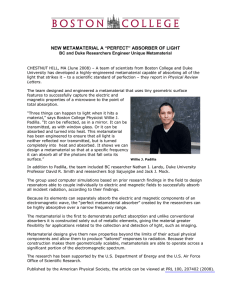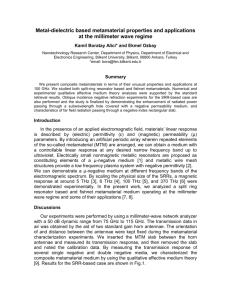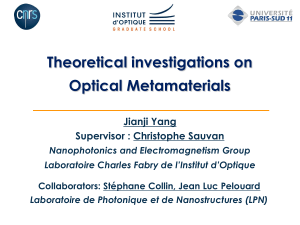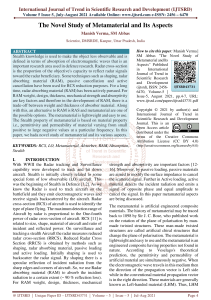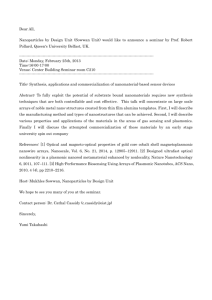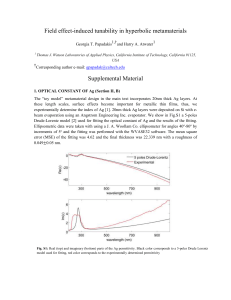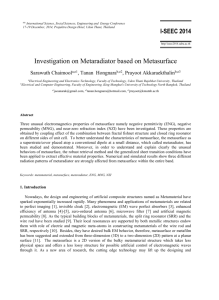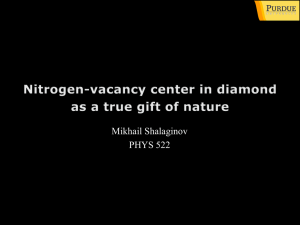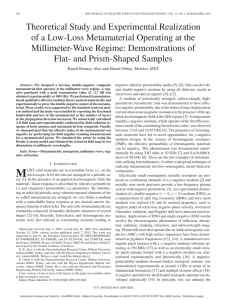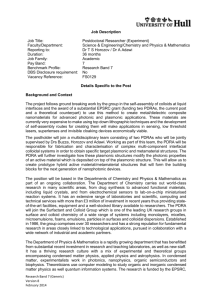Abstract
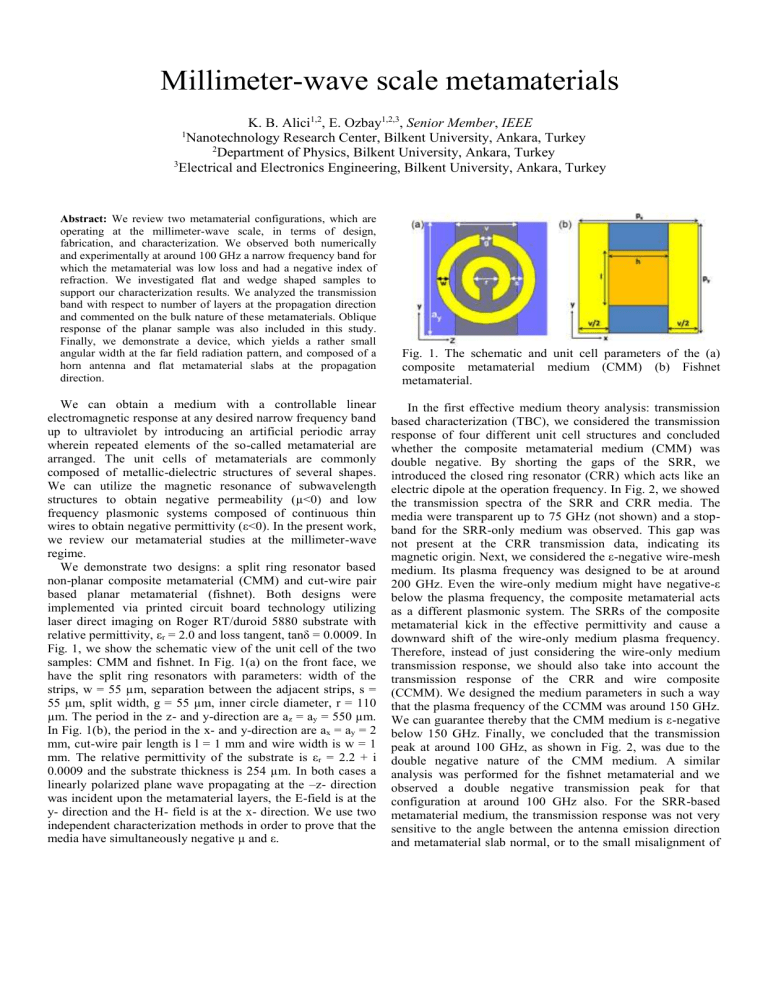
Millimeter-wave scale metamaterials
K. B. Alici
1,2
, E. Ozbay
1,2,3
, Senior Member , IEEE
1
Nanotechnology Research Center, Bilkent University, Ankara, Turkey
2
Department of Physics, Bilkent University, Ankara, Turkey
3
Electrical and Electronics Engineering, Bilkent University, Ankara, Turkey
Abstract: We review two metamaterial configurations, which are operating at the millimeter-wave scale, in terms of design, fabrication, and characterization. We observed both numerically and experimentally at around 100 GHz a narrow frequency band for which the metamaterial was low loss and had a negative index of refraction. We investigated flat and wedge shaped samples to support our characterization results. We analyzed the transmission band with respect to number of layers at the propagation direction and commented on the bulk nature of these metamaterials. Oblique response of the planar sample was also included in this study.
Finally, we demonstrate a device, which yields a rather small angular width at the far field radiation pattern, and composed of a horn antenna and flat metamaterial slabs at the propagation direction.
We can obtain a medium with a controllable linear electromagnetic response at any desired narrow frequency band up to ultraviolet by introducing an artificial periodic array wherein repeated elements of the so-called metamaterial are arranged. The unit cells of metamaterials are commonly composed of metallic-dielectric structures of several shapes.
We can utilize the magnetic resonance of subwavelength structures to obtain negative permeability (µ<0) and low frequency plasmonic systems composed of continuous thin wires to obtain negative permittivity (ε<0). In the present work, we review our metamaterial studies at the millimeter-wave regime.
We demonstrate two designs: a split ring resonator based non-planar composite metamaterial (CMM) and cut-wire pair based planar metamaterial (fishnet). Both designs were implemented via printed circuit board technology utilizing laser direct imaging on Roger RT/duroid 5880 substrate with relative permittivity, ε r
= 2.0 and loss tangent, tanδ = 0.0009. In
Fig. 1, we show the schematic view of the unit cell of the two samples: CMM and fishnet. In Fig. 1(a) on the front face, we have the split ring resonators with parameters: width of the strips, w = 55 µm, separation between the adjacent strips, s =
55 µm, split width, g = 55 µm, inner circle diameter, r = 110
µm. The period in the z- and y-direction are a z
= a y
= 550 µm.
In Fig. 1(b), the period in the x- and y-direction are a x
= a y
= 2 mm, cut-wire pair length is l = 1 mm and wire width is w = 1 mm. The relative permittivity of the substrate is ε r
= 2.2 + i
0.0009 and the substrate thickness is 254 µm. In both cases a linearly polarized plane wave propagating at the –z- direction was incident upon the metamaterial layers, the E-field is at the y- direction and the H- field is at the x- direction. We use two independent characterization methods in order to prove that the media have simultaneously negative µ and ε.
Fig. 1. The schematic and unit cell parameters of the (a) composite metamaterial medium (CMM) (b) Fishnet metamaterial.
In the first effective medium theory analysis: transmission based characterization (TBC), we considered the transmission response of four different unit cell structures and concluded whether the composite metamaterial medium (CMM) was double negative. By shorting the gaps of the SRR, we introduced the closed ring resonator (CRR) which acts like an electric dipole at the operation frequency. In Fig. 2, we showed the transmission spectra of the SRR and CRR media. The media were transparent up to 75 GHz (not shown) and a stopband for the SRR-only medium was observed. This gap was not present at the CRR transmission data, indicating its magnetic origin. Next, we considered the ε-negative wire-mesh medium. Its plasma frequency was designed to be at around
200 GHz. Even the wire-only medium might have negative-ε below the plasma frequency, the composite metamaterial acts as a different plasmonic system. The SRRs of the composite metamaterial kick in the effective permittivity and cause a downward shift of the wire-only medium plasma frequency.
Therefore, instead of just considering the wire-only medium transmission response, we should also take into account the transmission response of the CRR and wire composite
(CCMM). We designed the medium parameters in such a way that the plasma frequency of the CCMM was around 150 GHz.
We can guarantee thereby that the CMM medium is ε-negative below 150 GHz. Finally, we concluded that the transmission peak at around 100 GHz, as shown in Fig. 2, was due to the double negative nature of the CMM medium. A similar analysis was performed for the fishnet metamaterial and we observed a double negative transmission peak for that configuration at around 100 GHz also. For the SRR-based metamaterial medium, the transmission response was not very sensitive to the angle between the antenna emission direction and metamaterial slab normal, or to the small misalignment of
the layers. This was not the case for the planar metamaterial media such as the fishnet structure.
Fig. 2. The schematic and unit cell parameters of the (a) composite metamaterial medium (CMM) (b) Fishnet metamaterial.
Another well-developed characterization method of metamaterials is the standard retrieval procedure. The assigned effective refractive index (n) and relative impedance (z) values of the metamaterial slab can be extracted by using the complex scattering parameters with respect to 50 Ω. If the metamaterial slab under test is symmetric with respect to the x-y plane, i.e.
S
11
= S
22
and S
21
= S
12
, we can extract the effective medium parameters (n, z) of the metamaterial by using the terminology that was developed for the homogenous slab. By using ε = n z, and µ = n / z formula, we derive the effective permittivity and permeability of the media. The complex scattering parameters for the case of our metamaterial were obtained from the simulations and by using the formalism developed in literature.
We extracted the n, z; ε, µ parameters of the CMM medium and showed as Fig. 2 (b) and (c). It is clear that at around 100
GHz the CMM medium is double negative. The results for the fishnet metamaterial were in parallel and double negative band was at around 100 GHz. We demonstrated experiments supporting the negative behavior of the samples.
The split-ring resonator based metamaterial flat lens with five layers at the propagation direction was constructed and illuminated with oblique incidence. From the scanning experiments, we observed shifting of the beam to the negative side. The transmitter horn antenna was on the right-hand side of the metamaterial with respect to its central axis. We scanned the spatial intensity distribution along the second metamaterialair interface from 75 to 115 GHz. When the metamaterial was placed the transmitted beam appeared on the right-hand side.
Thereby, the index of refraction of the metamaterial medium was negative. By using the Snell’s Law of refraction, we determined the refractive index from the experiment. By using simple geometric equations and Snell’s Law we derived the other parameters: refraction angle, shift distance and refractive index, n = -1.0.
We studied a wedge shaped sample (meta-prism) in a different experiment and the calculations indeed also gave a negative index in agreement with the other analyses.
For the fishnet metamaterial, we numerically studied its response to an incident plane wave with a nonzero angle of incidence. As we rotate the metamaterial layer with respect to the y-direction with a rotation angle θ, we see a shift at the resonance frequency. Therefore, the narrow-band metamaterial does not operate at the same frequency anymore. When the angle of incidence with respect to x-axis (α) increases, we observe that the negative transmission peak dies out at the operation frequency. From these results we can also see the effect of a finite number of unit cells at one of the lateral directions. We concluded that planar metamaterials may not be suitable for superlens applications since their response is very sensitive to the angle of incidence.
Finally, we studied the far field radiation response of horn antenna and metamaterial slab composite. The composite had a lower angular width compared to the horn only case. The behavior of the hybrid structure composed of a horn antenna as driven element and CMM material as director can be considered as a novel phenomenon, which is similar to the behavior of Yagi-Uda antenna. The DNG part is passive and thin. It forms a rough image of the source. Its rough image and source itself can be used to explain the higher directivity of the composite system.
R EFERENCES
[1] K. B. Alici and E. Ozbay, “Direct observation of negative refraction at the millimeter-wave regime by using a flat composite metamaterial,” J. Opt. Soc.
Am. B, vol. 26, pp.1688-1692, 2009.
[2] K. B. Alici and E. Ozbay, “Characterization and tilted response of a fishnet metamaterial operating at
100 GHz,” J. Phys. D: Appl. Phys., vol. 41, pp.
135011(1)-(5), 2008.
[3] K. B. Alici and E. Ozbay, “Theoretical study and experimental realization of a low-loss metamaterial operating at the millimeter-wave regime:
Demonstrations of flat and prism shaped samples,” in press.
